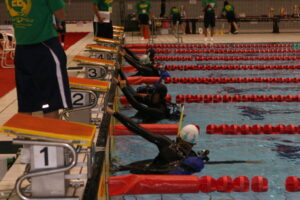
DIVING NEWS
Cannon ‘twinkled like gold’ on lost wreck

Marine archaeologist Klara Fiedler examines the wreck. (Picture: Morten Johansen / Viking Ship Museum in Roskilde)
Archaeologists have discovered a missing 17th-century warship wreck off Denmark said to be one of the first ships ever to be constructed from drawings.
The Delmenhorst was also the last of three missing ships from a naval engagement that marked the start of Denmark’s decline as a European superpower.
Deliberately grounded during the Battle of Fehmarn on 13 October, 1644, the wreck has been identified by marine archaeologists from the Viking Ship Museum in Oslo, Norway. Its scuba divers have been working against time since mid-August to survey and collect artefacts from the wreck before it is embedded in a new beach to be established at the site.
The Delmenhorst was discovered in just 3.5m of water, almost completely buried in the seabed 150m off the coast of Rødbyhavn in south Lolland, Denmark. It was found during construction work on what will be the world’s longest undersea tunnel, an 11-mile road/rail link between Denmark and Germany due to open in 2029.
The 31m ship was grounded in the final hours of the battle against a 42-strong Swedish/Dutch fleet in the hope that it could be defended by cannon fire from Rødbyhavn, but a Swedish “burner” ship was set ablaze and sent on a collision course with the Delmenhorst, causing it to catch fire and sink.
Of the Danish fleet of 17 vessels, two were sunk and the rest captured or dispersed in the engagement. Fehmarn was the final battle of the two-year “Torstenson Feud”, after which Sweden became the pre-eminent power in Scandinavia.
24 September 2020
The other two ships recorded as sunk in the battle, the Danish warship Lindormen and the Dutch armoured merchant vessel Swarte Arent, were found at around 24m in 2012, also during work on the tunnel.
Of the Delmenhorst, Morten Johansen of the Viking Ship Museum says: “We found an oval – ship-shaped, you could say – pile of stones densely overgrown with seaweed. It was quickly clear that it was ballast stone from a larger vessel, and between rocks and algae we could see the ship’s frames and inch-thick cladding planks.
“On the very first dive, the sun shone down through the water, and it made dozens of burst and melted pieces of bronze cannon twinkle like gold between the charred wreckage.” Four different sizes of cannonball were also found.
“The ship will remain in the environment where it has been for 400 years,” said Johansen. “We hope that in the future someone will find a way of deriving more knowledge from such a wreck than we are able to extract today.”
The divers have also been taking some 30,000 photos to build a 3D model of the Delmenhorst.
“In this way, the shipwreck can be exhibited digitally at the museum, even though it is still on the seabed,” said Johansen, adding that work was already under way on an exhibition about the three Fehmarn shipwrecks set for 2021.

The post Cannon ‘twinkled like gold’ on lost wreck appeared first on Divernet.
Read More Diving News Divernet














